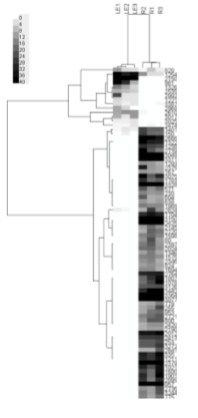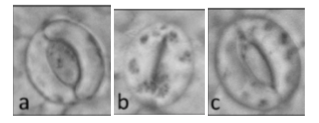- Anaerobic Parasite
- Aquatic Ecology
- Abiotic and biotic stress in plants
- Biochemistry and Physiology of Fruit Ripening
- Bovine and Ovine Biotechnologies
- Cell Biology and Biochemical Parasitology
- Comparative Neuroendocrinology
- Developmental Biology
- Environmental Microbial Ecology Laboratory
- Ichthyophysiology and Aquaculture
- Microorganism Plant Interactions
- Molecular Farming and Vaccines
- Molecular Parasitology
- Mycology and Edible Fungi
- Physiology and Assistance to Plant Breeding
- Phytobacteriology
- Photochemistry and Molecular Photobiology
- Plant Physiology
- Soil Microbiology
- Stem Cells and Gene Therapy
Microorganism Plant Interactions Laboratory
Head

- Fernando Pieckenstain, PhD - Independent Researcher CONICET. Adjunct Professor UNSAM pieckenstain@intech.gov.ar
Members

- María Elisa González, PhD - Adjunct Researcher CONICET . Teaching Assistant UNSAM mariaelisa@intech.gov.ar

- Nazareno Castagno, PhD - Assistant Researcher CONICET. Teaching Assistant UNSAM ncastagno@intech.gov.ar

- Diana Carolina Bedoya - Doctoral Fellow dbedoya@intech.gov.ar
Research Lines
In nature, plants constantly interact with a great variety of microorganisms, deeply affecting their growth, development and ability to adapt to changes in environmental conditions. At the Plant Microorganism Interactions Laboratory we study the relationships established between plants and pathogenic microorganisms, as well as beneficial microorganisms capable of promoting plant growth. At the same time, we study the interactions that occur between different microorganisms that make up the microbiota associated with plants. To do this, we carry out approaches that combine different methodologies and techniques of microbiology, biochemistry, genomics, and molecular and cellular biology. The knowledge of the complex interactions between plants and the members of the microbiota, allows designing strategies for disease control and improving the agronomic performance of crops.
Plant diseases caused by pathogenic microorganisms seriously affect agricultural production worldwide. Necrotrophic pathogens are characterized by displaying a complex machinery that leads to the death of infected plant cells, which allows them to use the nutrients released from them. The Botrytis cinerea fungus is one such pathogen and attacks hundreds of plant species throughout the world. B. cinerea is widely used as a model to study the pathogenicity mechanisms of necrotrophic fungi. In our laboratory, we study the mechanisms by which botrydial, a phytotoxic compound produced by B. cinerea, causes cell death in its hosts. Carrying out studies with model plants Arabidopsis thaliana and Nicotiana tabacum (tobacco), we found that botrydial is a tool used by B. cinerea to trigger the hypersensitive response in the plant, a type of programmed cell death that leads to the production of dead tissue. used by the fungus to feed itself (Rossi et al 2011). We are currently developing studies to identify botrydial targets and understand the mechanisms by which it triggers the hypersensitive response.

On the other hand, one of the events that occur during the hypersensitive response is the production of reactive oxygen species (ROS) at the site of infection, by plant cells. ROS play important roles as signal molecules and contribute to host cell death. In our laboratory we have verified that within the different sources of ROS, those produced in the chloroplast play an important role in the development of lesions caused by B. cinerea, and that modulation of the levels of ROS produced in the chloroplast can increase the plant resistance to B. cinerea (Rossi et al 2017). This work is part of a collaboration with the group of Plant Stress Biology, of the Institute of Molecular and Cellular Biology of Rosario
The interaction of B. cinerea with other microorganisms associated with its hosts
In addition to the role of botrydial in the generation of damage in plant tissues, we studied the role of this compound in the interaction of B. cinerea with the microorganisms that make up the microbiota associated with the hosts of B. cinerea. We have verified that this compound allows B. cinerea to exert antagonistic effects on different species of bacteria from the phylloplane of horticultural crops. In particular, we have verified that some species of the genus Bacillus, which have a proven potential for biological control of plant diseases, can be inhibited by B. cinerea through the action of botrydial (Vignatti et al, sent to publication). This finding has implications for the selection of microorganisms for their use as biological control agents for diseases caused by B. cinerea. One of the immediate perspectives of this line of research is the use of massive sequencing techniques to analyze the effects of botrydial on the composition of the microbiota associated with crops susceptible to attack by B. cinerea. In this line of research, we collaborate with the Laboratory of Molecular Biology of Bacteria Plant Interactions of the Faculty of Exact, Physical-Chemical and Natural Sciences, National University of Río Cuarto), the group of Biosynthetic Design of Fungicides (Faculty of Sciences, University of Cádiz, Spain) and the UMR-BIOGER (Institute National de la Récherche Agronomique, France)
Another line of work of the laboratory aims to know the composition and diversity of the bacterial communities associated with horticultural species, understand the mechanisms of colonization of plants by such microorganisms and identify those that have the potential to act as  biological control agents of diseases caused by pathogenic microorganisms. Some partial achievements have been the analysis of the composition of the communities of endophytic bacteria in tomato leaves (Romero et al 2014 and the identification of bacteria capable of promoting the growth of tomato plants and conferring protection against the attack of B. cinerea and others. pathogens (Romero et al 2016).
biological control agents of diseases caused by pathogenic microorganisms. Some partial achievements have been the analysis of the composition of the communities of endophytic bacteria in tomato leaves (Romero et al 2014 and the identification of bacteria capable of promoting the growth of tomato plants and conferring protection against the attack of B. cinerea and others. pathogens (Romero et al 2016).
In the course of our work we identified endophytic bacteria from leaves of horticultural species, and we set out to understand how they colonize the interior of such tissues. In particular, we are interested in determining whether endophytic bacteria that are beneficial to plants have the ability to colonize leaves using the stomatal pores as a route of entry. Such capacity has been demonstrated for some species of pathogenic bacteria, but not for beneficial bacteria. This topic is developed in conjunction with Dr Gustavo Gudesblat, from the Faculty of Exact and Natural Sciences of the University of Buenos Aires. This still incipient project has allowed us to identify bacteria that are capable of inducing the opening of stomata, and at the same time protect the plants against the attack of pathogens. At present we are studying the molecular mechanisms involved in this process, which have implications in the development of biological control agents capable of endophytically colonizing leaves after being applied foliarly.
The catabolism of polyamines in the defense mechanisms of plants against the attack of pathogens. Another line of work focuses on the role of polyamines, and in particular their catabolism, in the defense response signaling processes of plants against the attack of pathogens with different pathogenesis strategies. Polyamines are polycationic compounds essential for all living things. Their role as signal molecules in response to stressful situations has been widely studied (González et al 2011, Rossi et al 2015). In relation to this line of research, we are currently collaborating with the group of Dr. Margarita Rodríguez and Dominguez Kessler, from the Autonomous University of San Luis Potosí (Mexico) in understanding the role of different isoforms of Arabidopsis thaliana polyamino oxidases in the degradation of polyamines. , the generation of ROS and the signaling of defense responses (Jasso Robles et al 2016). Iron and phosphate solubilizing bacteria antagonists of phytopathogenic fungi of the genus Fusarium. Development of bioformulations to increase the productivity and quality of pastures in the Pampean region. This line of work aims at developing tools to increase soil fertility and pasture productivity in the Pampas region. The strategy is based on the selection and field application of microorganisms capable of promoting the growth of two species of grasses, fescue (Lolium arundinaceum) and wheatgrass (Thinopyrum ponticum) and two species of legumes, white clover (Trifolium repens) and red clover. (Trifolium pratense), which are part of highly relevant forage associations for the region. In particular, bacteria capable of promoting the growth of plant species are identified and evaluated by increasing the availability of phosphorus and iron, and also reducing the incidence of diseases caused by pathogenic microorganisms. The impact of the application of growth-promoting bacteria on the structure of plant communities and communities of soil microorganisms is also studied. This line is developed in conjunction with the INTECH Soil Microbiology Laboratory.
Publications
Flores-Hernández E, Gonzalez ME, Alvarado-Guitron P, Jasso-Robles FI, Ovando-Vázquez C, Jiménez-Bremont JF, Ćavar Zeljković S, Ulbrichová M, De Diego N, Rodríguez-Kessler M. Polyamine uptake transporter 2 is essential for systemic acquired resistance establishment in Arabidopsis. Plant Stress 18, 101046, 2025. https://doi.org/10.1016/j.stress.2025.101046
Gonzalez ME, Castagno LN, Sannazzaro AI, Ríos C, Gudesblat GE. Altabe SG, Bedoya-Castañeda DC, Estrella MJ, Pieckenstain FL. Description of Pseudomonas gorinensis sp. nov., a plant growth-promoting bacterium that modulates stomatal apertura. International Journal Of Systematic and Evolutionary Microbiology 75:006739. 2025 https://doi.org/10.1099/ijsem.0.006739
Peña-Lucio EM, Pieckenstain FL, Gonzalez ME, Flores-Hernández E, Rodríguez-Kessler M. The polyamine uptake transporters PUT2/LAT4 and PUT5/LAT5 contribute to Arabidopsis defense response against Botrytis cinérea. Physiology and Molecular Biology of Plants 31, 1053-1069. 2025. https://doi.org/10.1007/s12298-025-01630-1
Castagno LN, Sannazzaro AI, González ME, Pieckenstain FL, Estrella MJ. Phosphobacteria as key actors to overcome phosphorus deficiency in plants. Annals of Aplied Biology 178: 256–267. 2021. https://doi.org/10.1111/aab.12673
Cumpa-Velásquez LM, Moriconi JI, Dip DP, Castagno LN, Puig ML, Maiale SJ, Santa María GE, Sannazzaro AI, Estrella MJ. Prospecting phosphate solubilizing bacteria in alkaline-sodic environments reveals intra-specific variability in Pantoea eucalypti affecting nutrient acquisition and rhizobial nodulation in Lotus tenuis. Applied Soil Ecology 168, 104125. 2021. https://doi.org/10.1016/j.
Gonzalez ME, Jasso Robles FI, Flores Hernández E, Rodríguez Kessler M, Pieckenstain FL. Current status and perspectives on the role of polyamines in plant immunity. Annals of Aplied Biology 178: 244–255. 2021. https://doi.org/10.1111/aab.12670
Rossi FR, Gárriz A, Marina M, Pieckenstain FL. Modulation of polyamine metabolism in Arabidopsis thaliana by salicylic acid. Physiologia Plantarum 173, 843-855. 2021. https://doi.org/10.1111/
Chaín JM, Tubert E, Graciano C, Castagno LN, Recchi M, Pieckenstain FL, Estrella MJ, Gudesblat G, Amodeo G, Baroli I. Growth promotion and protection from drought in Eucalyptus grandis seedlings inoculated with beneficial bacteria embedded in a superabsorbent polymer. Scientific Reports 10, 18221. 2020. https://doi.org/10.1038/s41598-020-75212-4
Jasso-Robles FI, Gonzalez ME, Pieckenstain FL, Ramírez-García JM, Guerrero-González ML, Jiménez-Bremont JF, Rodríguez-Kessler M. Decrease of Arabidopsis PAO activity entails increased RBOH activity, ROS content and altered responses to Pseudomonas. Plant Sci. 292: 110372. 2020. https://doi.org/10.1016/j.plantsci.2019.110372
Vignatti P, Gonzalez ME, Jofré EC, Bolívar-Anillo HJ, Moraga J, Viaud M, Collado IG, Pieckenstain FL. Botrydial confers Botrytis cinerea the ability to antagonize soil and phyllospheric bacteria. Fungal Biol. 124: 54-64. 2020. https://doi.org/10.1016/j.funbio.2019.11.003
Marina M, Romero FM, Villarreal NM, Medina AJ, Gárriz A, Rossi FR, Martinez GA, Pieckenstain FL. Mechanisms of plant protection against two oxalate-producing fungal pathogens by oxalotrophic strains of Stenotrophomonas spp. Plant Mol Biol. 100: 659-674. 2019. https://doi.org/10.1007/s11103-019-00888-w

